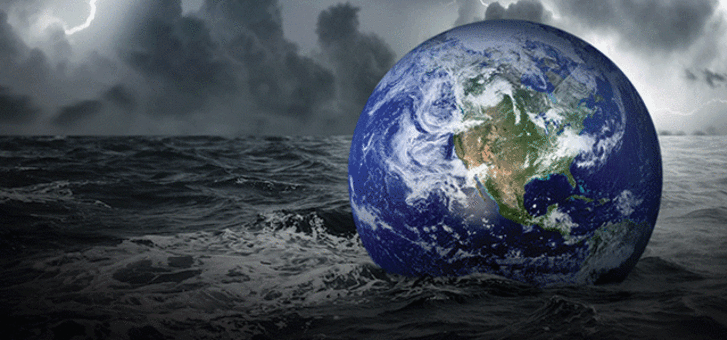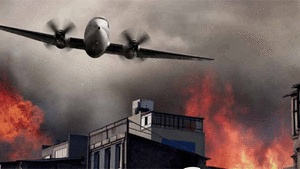It is argued that what turns a significant event into a crisis is when it affects you. When tragedy touches someone else in an unfamiliar part of the world, it’s somehow less of a crisis and more just “a shame.” “What a shame about those attacks! Think of it—here, in this country... Well, I must take the dog for a walk ...”
Genocide in Rwanda is a tragedy of immense proportions, but it’s easy to see it as somebody else’s problem when you’re removed from it by thousands of kilometres. A tornado, flood or fire devastating someone else’s town is disastrous. But when it smashes through yours—and it’s you who’s sifting through the ruins of your home picking photos out of the mud and you don’t have a place to sleep or clean water to drink—then it’s a crisis.
On many levels we’ve reached a crisis point as a planet. The reason this is important to realise is that in the Bible, Jesus went to great lengths to point out observable indicators that would portend the end of the world and His return to earth.
And what Jesus revealed then indicates strongly that we’re now living in the time to which He then referred.
Having spoken of signs in the religious world, of international conflicts, natural disasters and disease, He announced His second coming by saying, “When you see all these things, you know that it is near, right at the door” (Matthew 24:33; italics added).
It certainly isn’t alarmist to believe we’re living in the crisis that precedes the return of Jesus. And wisdom suggests that people should read such signs for what they are: indicators that time is short for Planet Earth, even if we don’t know just how brief that might be.
Failed Predictions
I am as aware as anyone that through the years, people seeking to impress upon others the shortness of time have written and said a lot of embarrassing things.
One of the first books I read on the subject of Bible prophecy seemed to imply that Jesus’ return could take place in 1988. Since then, over more than 20 years, people who have attached dates to the prophecies of the Bible have come and gone. Not surprisingly, every one of them has been dead wrong.
And while you might not call their views a “prediction” as such, even the disciples of Jesus had it wrong about the second coming of the Messiah.
On the very day Jesus ascended to heaven, His disciples asked Him, “ ‘Lord, are you at this time going to restore the kingdom to Israel?’ He said to them: ‘It is not for you to know the times or dates the Father has set by his own authority’ ” (Acts 1:6, 7).
In spite of having spent more than three years with Jesus, in spite of having witnessed miracles, in spite of having been instructed by the best Bible Teacher who had ever lived, the disciples were still confused about the return of Jesus!
Signs Of The Times
While history reveals the folly of setting dates for the coming of Jesus, God has told us that we could know when it would grow near. And that’s where we are today. Near.
How can we be so sure? Jesus gave us signs to read. Verifiable, concrete signs. Empirical evidence. He said, “Look for this, you’ll be able to see that and you’ll notice something else.” This isn’t like reading tea leaves.
It’s true that some—even many—predictions aren’t worth the paper they’re printed on, but in looking at the world around us and analysing what we see in relation to the prophecies of the Bible, we’re not predicting anything. The One who made the predictions was Jesus. All we need to do is open our eyes—and our minds—to see that what He foretold has begun to come to pass.
However, instead of trying to figure out how many days there are before Jesus returns; instead of seeing every earthquake as a harbinger of the end, we should see the signs of the times as what they really are: signs. Of the days in which we live. And the period in which we live is close to the return of Jesus.
Looking For The End
My wife and I have driven across the United States on numerous occasions, most often on Interstate 40. Stretching all the way from North Carolina in the east of the continent to California in the west, I-40 is 4000 kilometres long and we’ve tra-
velled all but 300 kilometres of it several times and in both directions.
When you’re heading out of the Mojave Desert with several days on the road ahead of you, it isn’t very important to know exactly how many kilometres it is to where you’re going. No doubt you would have a rough idea and you recognise that if you make so much progress each day you will get to where you’re going about the right time.
But what is vital is to be sure which road you’re on. Your primary concern is making sure you don’t take a wrong turn. Should you turn on to I-15 you will be headed in the wrong direction. What you want is I-40. So how can you know one road from the other?
Because we did the majority of our cross-country driving in the days before GPS became ubiquitous, we had to rely on old-fashioned tools such as maps. Maps and signs. If we’re heading to North Carolina, we make sure we’re on Interstate 40; and the way you know that for sure is by looking for the blue-and-red shield-shaped sign with “40” emblazoned on it.
Even after driving for a day or two, the distance left to travel isn’t a driver’s primary concern. That is, you know you have two or three days of travel left. But as long as every now and then the signs saying “40” come into view, you recognise that you are on the right road.
In fact, unless your destination is a major city, it isn’t usually until you get close to it that signs appear stating how many kilometres you have left.
It’s a lot like that with the signs of Jesus’ return. An earthquake or a war doesn’t mean anyone should rush to look at the sky to see if Jesus is on His way. But while those things don’t necessarily indicate His return is imminent, they do suggest that we can have confidence in what Jesus said—particularly when the signs are occurring with frequency and fury.
In The Midst Of Crisis
The Bible has alerted us that we will be living in a time of real crisis before Jesus comes back. The prophet Daniel described it as being “a time of distress such as has not happened from the beginning of nations” (Daniel 12:1). Paul called earth’s final days “terrible” (2 Timothy 3:1) and Jesus predicted that there would be a “great distress” (Matthew 24:21). As my children would say when they were very young and we were pulling out of our driveway with a long journey ahead of us, “Are we there yet?”
So let’s consider: terrorism, runaway population growth, soil degradation, water shortages, killer pollution, ecological chaos, natural disasters, health crises, disease. And we haven’t talked about the economy or a host of other things—such as violence.
And yes, there have been school shootings, natural disasters, public health issues, ecological and environmental challenges and terrorism before now. But it hasn’t ever been like it is now. Ever.
If what we’re living through is normal, then let’s just roll over and go back to sleep. But it isn’t possible to witness the world around us and begin to contemplate that this is anything approximating normal. The planet is in crisis.
But looking ahead to the crisis of earth’s final days, we can have confidence in God’s faithfulness and power. Should He choose to do so, He is able to deliver us from crisis. But should He not decide to do so, He is able to sustain us in the midst of crisis.
Signs Of The End
What are the signs that Jesus says indicate that we are living close to the time of his second coming?
“You will hear of wars and rumours of wars, but see to it that you are not alarmed. Such things must happen, but the end is still to come. nation will rise against nation, and kingdom against kingdom. there will be famines and earthquakes in various places. All these are the beginning of birth pains."
“Then you will be handed over to be persecuted and put to death, and you will be hated by all nations because of me. At that time many will turn away from the faith and will betray and hate each other, and many false prophets will appear and deceive many people. Because of the increase of wickedness, the love of most will grow cold, but the one who stands firm to the end will be saved. And this gospel of the kingdom will be preached in the whole world as a testimony to all nations, and then the end will come” (Matthew 24:6 –14)
Extracted, with permission, from Confidence in Chaos, by John Bradshaw (Review and Herald, 2014).






